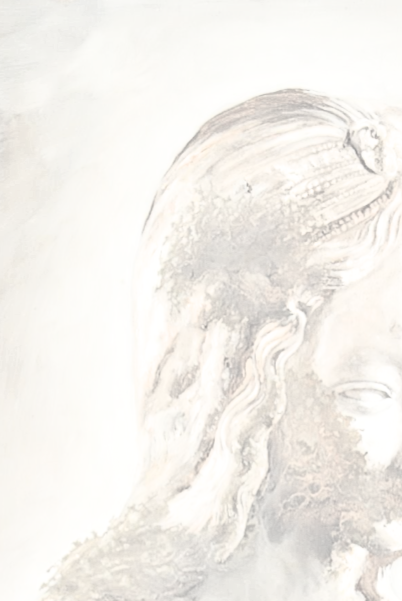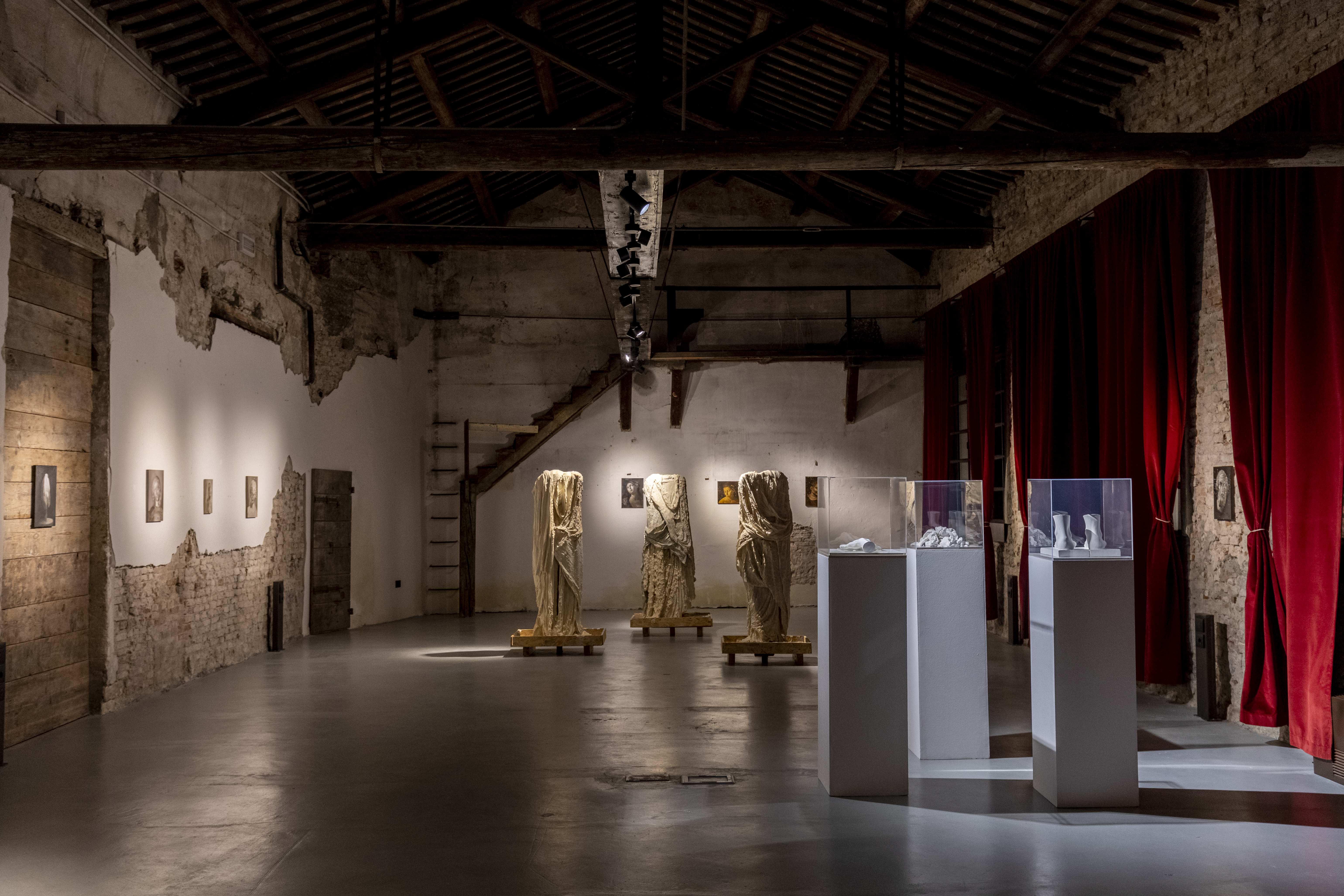
CHANGING SHAPES
Opening 21/10/2023 h 18:00 > 21:00
21/03 > 25/11/2023*
NP-ArtLab
Vicolo dell’Osservatorio 1/C
35122 - Padova (PD)
*exhibition space
Wednesday - Saturday, 12.00 - 19.00
More info: info@npartlab.com
Opening 21/10/2023 h 18:00 > 21:00
21/03 > 25/11/2023*
NP-ArtLab
Vicolo dell’Osservatorio 1/C
35122 - Padova (PD)
*exhibition space
Wednesday - Saturday, 12.00 - 19.00
More info: info@npartlab.com
NP-ArtLab presents the exhibition CHANGING SHAPES with works by Leonardo Dalla Torre, Giulio Paolini and Frédérique Nalbandian.
Three artists of different generations, united by a strong interest in the classical world but proposed with different eyes. Fragments and busts of statues alternate with images belonging to the History of Art and the Masters of painting of the past.
The three sculptures by Giulio Paolini (Genoa, 1940), made of plaster, are named 'Proteus', 'Proteus (II)' and 'Proteus (III)', referring to the mutable Greek god who had the ability to transform himself into any form he wished. Quotation, duplication and fragmentation are the three themes that emerge in this series and summarise the intellectual themes dear to the artist himself. Like the multiform Proteus, this sculptural group can be admired from different angles, creating a poetic meditation on the metaphysical nature of artistic practice.
A pictorial vision of classicism is offered to us by Leonardo Dalla Torre (Venice, 1995). In the space he paints, bodies, faces and gazes take shape, evoked by the forms of past painting outlined by the Masters of Art History. They are used as a pretext for an unexpected intervention. Form is often compromised, subtracted and distorted.
The dialogue continues with the French artist Frédérique Nalbandian (Menton, 1967). Three imposing busts, made by working and handling Marseille soap, are named 'Panacée I', 'Panacée II' and 'Panacée III' and represent the Greek goddess of universal healing. The long drapes covering the goddess' bodies recall the expressiveness of the classical period. If the visitor were able to touch the works after wetting his or her hands, a process of change of the material itself would be triggered, making the sculpture constantly becoming and changing. As a result, a further dialogue with contemporaneity is created, involving the viewer in the creative process of the work itself.
CHANGING SHAPES is closely linked to the concept of change and fragmentation of the material and the perception of the work itself. A continuous becoming that allows the observer to meditate and reflect on the metaphysical nature of the artistic practice of the three different artists in dialogue with each other.
Leonardo Dalla Torre was born in Venice in 1995. He grew up in the city's historic centre and graduated from the Liceo Artistico Statale in Venice in 2013, continuing his studies at the Accademia di Belle Arti in Venice, graduating in Painting in 2017 and in Graphic Art-Design in 2019. As a painter, he deepens his research by investigating figuration and portraiture as his main themes.
The models used draw both from the images of the History of Art and the Masters of painting of the past, and from his own contemporaneity, alienating contextual differences, accumulating the expressive characters of the body and the flesh, detecting their symptoms and openness in a painting that seeks the imminence of a calamity, suspending the images in a perpetual deflagration.
Giulio Paolini born on 5 November 1940 in Genoa, Giulio Paolini lives in Turin Since his first participation in a group show in 1961 and his first solo exhibition in 1964, he has exhibited in galleries and museums all over the world. Major retrospectives have been held at the Stedelijk Museum, Amsterdam (1980), Nouveau Musée, Villeurbanne (1984), Staatsgalerie Stuttgart, Stuttgart (1986), Galleria Nazionale d'Arte Moderna, Rome (1988), Neue Galerie am Landesmuseum Joanneum, Graz (1998) and Fondazione Prada, Milan (2003). Recent anthological exhibitions include those at the Whitechapel Gallery, London (2014), Fondazione Carriero, Milan (2018) and Castello di Rivoli Museo d'Arte Contemporanea, Rivoli-Turin (2020).
He has participated in several Arte Povera exhibitions and has been invited several times to the Kassel Documenta (1972, 1977, 1982, 1992) and the Venice Biennale (1970, 1976, 1978, 1980, 1984, 1986, 1993, 1995, 1997, 2013).
In 2022, he was awarded the Imperial Prize for Painting, the most important award in the field of art. His work can be found in renowned public and private collections both nationally and internationally.From the very beginning, Paolini has accompanied his artistic research with reflections collected in books he has edited himself: from Idem, with an introduction by Italo Calvino (Einaudi, Turin 1975), to Quattro passi. Nel museo senza muse (Einaudi, Turin 2006) and L'autore che credeva di esistere (Johan & Levi, Milan 2012). He has also created sets and costumes for theatrical productions, among which the projects created with Carlo Quartucci in the 1980s and the sets for two operas by Richard Wagner directed by Federico Tiezzi (2005, 2007) stand out.
Frédérique Nalbandian is a French multidisciplinary artist born on 3 April 1967 in Menton. A sculptor, she also creates drawings, installations and performances. Most of her in situ soap sculptures evolve both internally and externally, changing over time. Sometimes interactive, they require the visitor's participation. After taking her first drawing courses during her studies at Davis High School (en) in California, Frédérique Nalbandian entered the Ecole Nationale d'Art Décoratif d'Aubusson in 1988, where she spent a year, before entering the Ecole Nationale Supérieure d'Art in Villa Arson in 1989 to devote herself to artistic creation.
In 1994, she obtained an artistic residency dedicated to drawing at the Fondazione Ratti in Como under the direction of Anish Kapoor and Karel Appel. In 1996, she obtained the Diplôme National Supérieur d'Expression Plastique (DNSEP).
She sculpts soap, carving it or modelling it. Its different states: solid, liquid, foam, effervescence, dripping, stalactitisation derive from the action of water.
In her works she also uses poor materials such as plaster (in the mouldings and plastered roses), water, fabric, wool threads, glass and terracotta.
She moulds soap, shapes it and creates forms that she stops or lets evolve, transforming time into a medium. Her vocabulary of plastic forms is constantly expanding: precipitates, collapses, rolls, fragments, columns, partitions, walls, ropes or directly related to the anatomy of the human body: ears, brains, skins, skulls, hands, phalluses. Some were imposed by the material itself. Her forms, in their composition and the process they undergo, become poetic, charged with a metaphysics of matter that evokes the passage of time, erosion, transformation and metamorphosis. The allusion to Francis Ponge's text “Le Savon” was decisive from the outset and took shape during a series of talks in Cerisy during the Contemporary Writer's Workshops in 2015, where she met Pascal Quignard.



